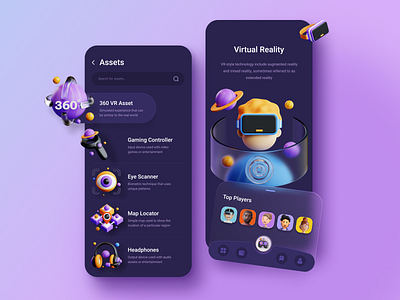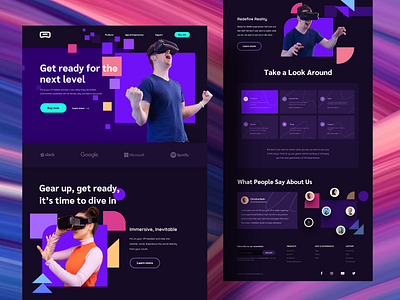Augmented Reality (AR) and Virtual Reality (VR) are two of the latest and most innovative technologies that have the potential to change the way we interact with our mobile devices.
AR and VR allow for a more immersive experience, creating a virtual environment that can be used for a wide range of purposes, from gaming and entertainment to education and business. In this article, we will explore how AR and VR can be used in mobile apps and what benefits they bring to the table.
Benefits of AR and VR in Mobile Apps
Before diving into the practical application of AR and VR in mobile apps, it’s worth mentioning the benefits that these technologies bring to the table. Here are a few of the most notable benefits:

Improved User Experience
One of the primary benefits of AR and VR in mobile apps is that they can greatly improve the user experience. These technologies allow users to interact with digital content more naturally and intuitively, creating a more immersive experience.
Increased Engagement
By making use of AR and VR technologies, mobile app developers can create more engaging and interactive experiences for their users. This increased engagement can lead to higher levels of user satisfaction and, in turn, better app retention rates.
Enhanced Learning
AR and VR can also be used to create educational and training apps that provide users with a more immersive and interactive learning experience. These technologies can help to make learning more fun and engaging, allowing users to retain information more effectively.
Increased Productivity
Finally, AR and VR can be used to create productivity apps that allow users to perform tasks more efficiently and effectively. For example, AR-powered apps can be used to display digital content over real-world objects, making it easier for users to find what they are looking for.
How to Implement AR and VR in Mobile Apps
Now that we’ve explored the benefits of AR and VR in mobile apps, let’s take a closer look at how these technologies can be implemented in a practical sense.

AR
AR involves adding digital content to the real world, creating a hybrid environment in which the real world and digital content interact. There are a few key components that are essential for implementing AR in a mobile app:
a. Camera
The first component of an AR-powered mobile app is the camera. This is used to capture the real-world environment and overlay digital content on top of it.
b. Augmented Reality SDK
The next component is an Augmented Reality SDK (Software Development Kit), which is used to develop the AR functionality of the app. There are several AR SDKs available, including ARKit (for iOS) and ARCore (for Android), both of which are provided by Apple and Google respectively.
c. Development Platform
Finally, a development platform, such as Unity or Unreal Engine, can be used to build the AR functionality of the app. These platforms provide the tools and resources needed to create and integrate AR into a mobile app.
VR
VR, on the other hand, involves creating a completely virtual environment in which the user can interact with digital content. Here are the key components of a VR-powered mobile app:
a. Head-Mounted Display (HMD)
The first component of a VR-powered mobile app is a Head-Mounted Display (HMD), which is used to display the virtual environment. There are several HMDs available on the market, including the Oculus Quest and the HTC Vive, both of which provide a high-quality VR experience.
The next component is a VR SDK, which is used to develop the VR functionality of the app. Some popular VR SDKs include Oculus SDK, SteamVR, and Vuforia.
c. Development Platform
Finally, a development platform, such as Unity or Unreal Engine, can be used to build the VR functionality of the app. These platforms provide the tools and resources needed to create and integrate VR into a mobile app.
Best Practices for AR and VR in Mobile Apps
To make the most of AR and VR in mobile apps, it’s important to follow best practices. Here are a few tips to keep in mind:

Keep it Simple
When it comes to AR and VR, it’s important to keep things simple. Avoid adding too many complex features or elements that can confuse or overwhelm users. Stick to a few key features that are easy to understand and use.
Consider User Comfort
Another important consideration is user comfort. Make sure that the AR and VR experiences you create are comfortable and easy to use, with no nausea-inducing motion or disorienting elements.
Optimize for Performance
To ensure a smooth and seamless AR and VR experience, it’s important to optimize the app for performance. Make sure that the app runs smoothly, without any lag or stuttering, and that the AR and VR elements are integrated seamlessly into the overall user experience.
Test Thoroughly
Finally, it’s important to test the AR and VR elements of your app thoroughly. Make sure to test the app on different devices and in different environments, and make any necessary adjustments to ensure the best possible experience for your users.
Conclusion
AR and VR are two of the most exciting and innovative technologies available today, and they have the potential to greatly improve the way we interact with our mobile devices.
From gaming and entertainment to education and business, there are countless applications for AR and VR in mobile apps. By following the best practices outlined in this article, mobile app developers can create engaging, interactive, and effective AR and VR experiences for their users.



















